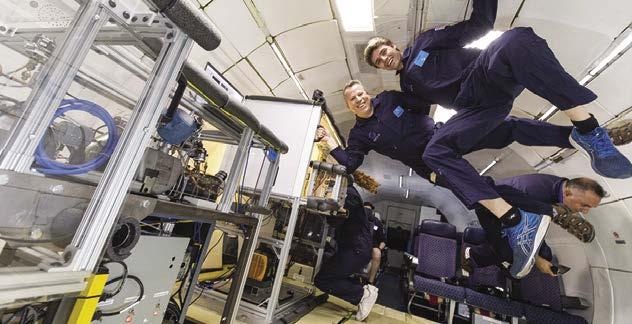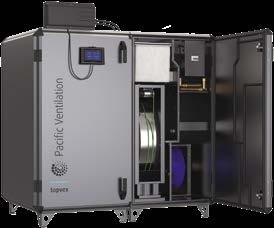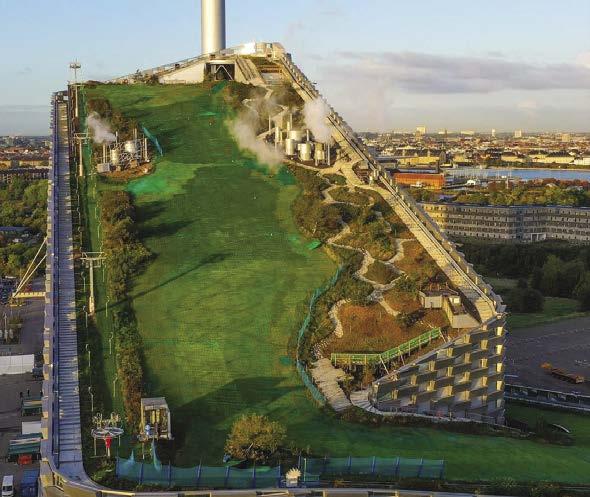
10 minute read
Green Wedge
from HVAC&R Nation October 2021
by AIRAH
HEDONISTIC SUSTAINABILITY
In Denmark, a power plant that converts trash to energy just happens to also be a year-round ski slope.
Advertisement
Copenhagen is home to the “cleanest waste-to-energy power plant in the world”, but it’s another aspect of the facility that has really captured people’s imagination. It also operates as a 400m artificial ski slope.
CopenHill, as the 90m tall structure is known, is capable of converting 440,000 tonnes of waste into clean energy annually.
Designed by Danish architecture firm BIG, CopenHill doubles as a centre for public recreation. In addition to the ski slope on its roof, it also features tree-lined hiking trails and an 85m high artificial climbing wall – described as the world’s tallest – on its facade.
“CopenHill is so clean that we have been able to turn its building mass into the bedrock of the social life of the city,” says BIG founder Bjarke Ingels. “Its facade is climbable, its roof is hikeable and its slopes are skiable.”
Copenhill’s blocky facade is constructed from 1.2m and 3.3m wide aluminium bricks.
Inside, it contains waste-treatment and energy-production tech capable of incinerating sufficient waste to provide clean electricity and district heating for 150,000 homes annually.
Also housed in the structure are a rooftop bar, cross-fit area and a lush garden. There are 10 floors of naturally lit administrative space and an education centre.
“To me, CopenHill is a perfect example of the world-changing power of architecture,” Ingels says. “We have the power to give form to the future that we want to live in.”
Copenhagen is aiming to become the world’s first carbon-neutral city by 2025. ■
There’s a whole other world of HVAC&R to discover in Ecolibrium magazine.



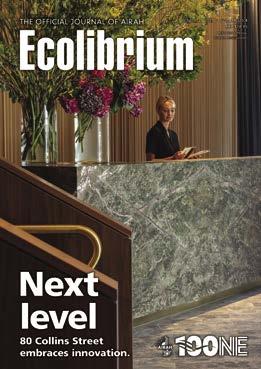
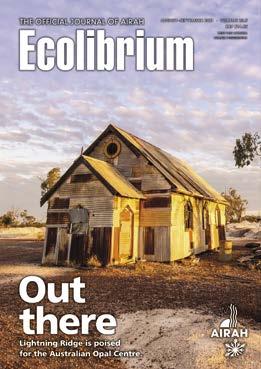
Get a taste of AIRAH’s official journal at www.airah.org.au/ecolibrium
PROUDLY SPONSORED BY
Skills summary
■ What?
A guide to ensuring suitable access to cooling tower equipment.
■ Who?
Relevant for HVAC&R technicians and anyone involved in installing, commissioning, and maintaining cooling towers.
UNDERSTANDING COOLING TOWER ACCESS
Cooling tower design and installation have improved significantly in recent years, with technology such as automated dual biocide dosing and remote monitoring equipment entering the market. Despite this, there remain common issues that arise during commissioning and when the risk management plan (RMP) is under development. A recurrent issue is access, or lack thereof, to cooling tower drift eliminators and related access panels. Good design and installation are the keys to avoiding these problems and averting ongoing safety issues and possible community health concerns in relation to a newly operating cooling tower. In addition to the state-based legislation (e.g., the Victorian Public Health and Wellbeing Act 2008), there are multiple other legislative documents that govern the installation and maintenance of a cooling tower in each jurisdiction. Please confirm the rules in your state or territory.
Easy and safe access
AS/NZS 3666 states that easy and safe access for cleaning, inspection and maintenance shall be available to all plant, equipment and components. If access to all parts of the system is not made available at the time of commissioning it will, in all likelihood, compromise this critically important function and/or the safety of maintenance workers. A cooling tower that is not optimised at the time of commissioning may waste water, energy and chemicals, potentially compromising public safety and the safety of those tasked with operating and maintaining it. One of the main points of contention is access to drift eliminators. AS/NZS 3666 states that drift eliminators shall be provided and installed in a manner that facilitates the ease of inspection, cleaning and maintenance. The drift eliminators should be designed for in situ cleaning or capable of being withdrawn without damage for cleaning. Most manufacturers recommend inspections every three months at a minimum. Drift eliminators are increasingly being identified as impasses in the Risk Management Plan and auditing process or by local and state authorities.
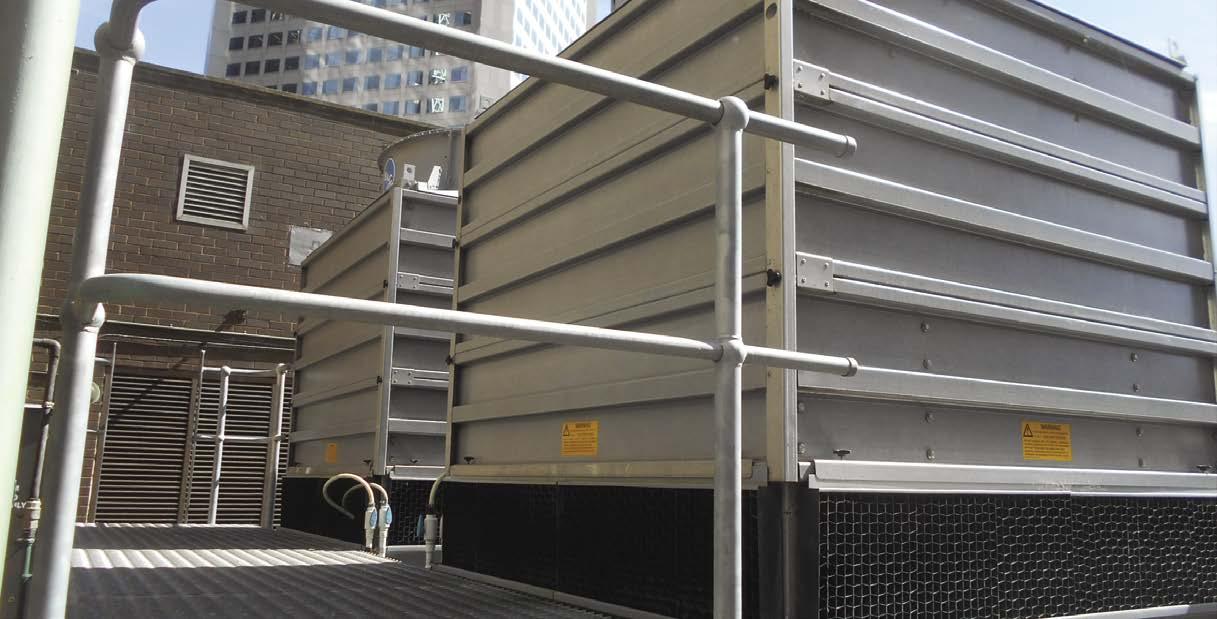
The good, the bad and the ugly
The following examples highlight best and worst practice when it comes to providing access to different varieties of cooling towers in varying locations.
This is a forced-draught counter-flow cooling tower that has drift eliminators installed at the top of the tower. There is no immediate safe access to these components for cleaning and maintenance. The site in question could also employ a knuckle or boom lift to gain access.

This is an induced-draught cooling tower with an access panel on the side of the tower. This panel can be removed to allow access to the internal components, including the drift eliminators. Due to the elevation involved, this tower has a purpose-built access ladder and platform installed to improve access.
Mobile platform ladders can be a very cost-effective way to gain access to side panels and drift eliminators. Careful selection is required to ensure the correct size and height ladder is selected to maintain the safety of workers. Purpose-built access ladder and platforms are designed to be site specific and can be made to any size and application. The platform shown allows access for the removal of drift eliminators at the top of the cooling towers and gives service and maintenance personnel access to spray distribution pipework and nozzles, as well as the top of fill pack or condenser coils.
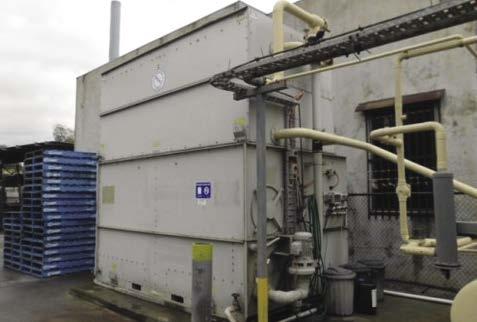
The installation of this equipment offers little or no access to the drift eliminators for cleaning and maintenance.
The cooling tower’s positioning restricts access to the drift eliminators for cleaning and maintenance.
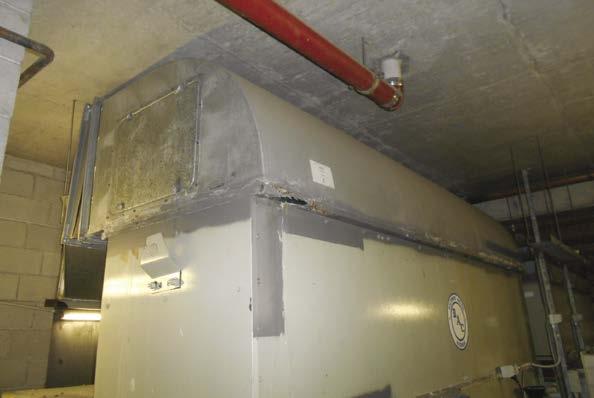
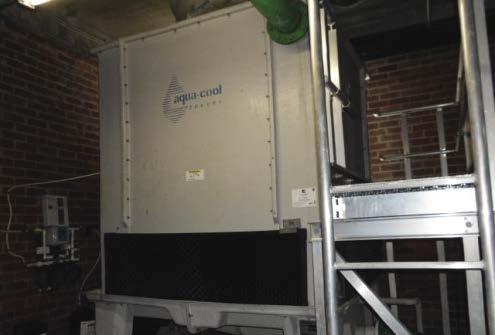
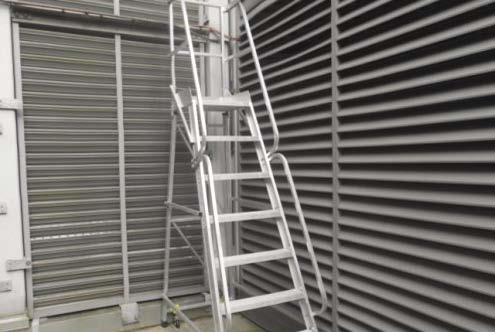
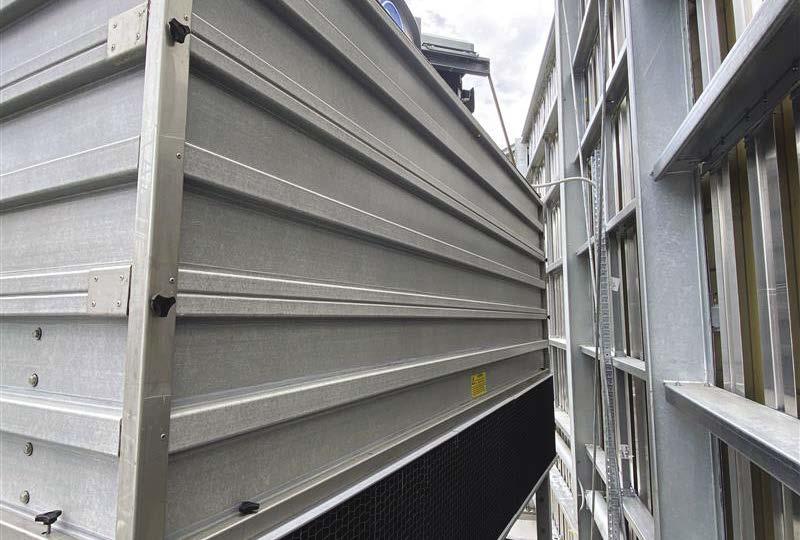
Cooling towers and Legionella
Why is cooling tower cleaning important?
Cooling towers make an ideal breeding ground for Legionella bacteria to colonise, and as such are commonly investigated as the source of Legionnaires’ disease outbreaks.
What is Legionella?
Legionella is a naturally occurring bacteria found in soil and water. It can be dangerous, even in low concentrations, but when able to thrive and colonise it becomes a severe health risk. Colonisation typically occurs in temperatures between 35–46°C, in the presence of algae and other organic matter. Legionnaires’ disease (Legionellosis) is a severe form of pneumonia caused by colonisation of the respiratory tract with Legionella bacteria. It is contracted either through the inhalation of water aerosols containing the bacteria or through aspiration (when contaminated water particles are breathed into the lungs while choking during drinking, ingesting or swallowing). A person infected initially presents with various flu-like symptoms, such as headache, muscle pain and illness before moving through more severe ailments such as high fever, chills, vomiting and nausea, diarrhoea, dry cough, chest pains and difficulty breathing. Legionnaires’ disease poses a particular risk to those over 50, people with chronic respiratory conditions or chronic lung disease, heavy drinkers and smokers, diabetics, and people with weakened immune systems or other diseases.
Can we prevent outbreaks?
Outbreaks are not uncommon, particularly during the warmer months due to the ideal conditions created in warm water systems. An ageing population and enhanced methods of detection have also been linked to the increase in detected cases, but unfortunately testing does little to prevent the infections. The maintenance and health of built water systems is the surest method to reduce the risks of Legionella colonisation. Control measures such as cooling tower registration, regular testing and attentive plant maintenance make a significant impact in the prevention of outbreaks.
Duty holder responsibilities
Duty holders are responsible for the elimination or, if this is not reasonably practicable, the minimisation of risks to the health and safety of any person associated with the manufacture, installation, operation, maintenance, inspection or testing of cooling towers. These are summarised as follows:
Designers and manufacturers
Designers and manufacturers must review the design and eliminate or, where this is not reasonably practicable, minimise risks to health and safety of any person associated with the plant arising from the design, including equipment orientation.
Building owners
Building owners must provide a means of safe access and egress to the plant (ideally this is by means of a range of fixed stairways, ladders and/or walkways) and provide relevant health and safety information and instruction for anyone involved in the operation, maintenance, testing or cleaning of the plant.
Employers
Employers of people responsible for the operation, maintenance, cleaning, inspection or testing of cooling towers must ensure the health and safety of those involved. They must provide workers with information, instruction and training to ensure their health and safety and a safe working environment to minimise the risks associated with their tasks.
Non-compliance
Where safe access is not present or safe work procedures are not implemented that enable an authorised officer or independent inspector to conduct and complete a comprehensive inspection of all necessary components of a cooling tower, the relevant authority may take enforcement action as deemed necessary in the circumstances. This may include the forced shut-down of the system until such time as the safe access and safe work procedures are provided by the system owner.
Assessing the risk of a fall
Without appropriate guarding, workers involved in undertaking inspections, cleaning and maintenance of cooling towers are typically exposed to the fall from heights including from rooftops. Once you identify a fall hazard, you must assess the likelihood of a fall occurring. If any of the following factors are present, there is a risk:
The task
• Workers are handling cumbersome or unstable objects • The task is lengthy and has lengthy exposure to the risk • Workers are using chemicals that may cause dizziness or disorientation • New or inexperienced workers involved.
The working environment
• The slope of the raised work surface makes it difficult to maintain balance • Slippery (wet, oily, dusty or glazed) work surface • Uneven work surface • Surface too cramped, impeding free movement • Work materials, tools or debris clutters the surface • Adverse weather conditions • Unprotected edges or penetrations obscured by light or obstructions • Materials, large tools or equipment must be manually transported • Numerous other contractors or trades in the same work area simultaneously. AS/NZS 3666.2 gives guidance on the selection of appropriate personal protective equipment (PPE) during the maintenance of air handling and water systems.
JOB POTENTIAL HAZARD RESPIRATOR AND CLOTHING
Inspection Aerosol
High pressure spraying Aerosol
Chemical treatment with medium hypo-chlorite solution ventilated space Spray mist and very low concentration chlorine Half face piece, Class P1 or Class P2 particulate filter, ordinary work clothing
Respirator, as above, waterproof overalls, gloves, boots, goggles or face shield
Half face piece, acid gas and particulate respirator, goggles or face shield, overalls, gloves and boots
As above and still air but not confined space Low concentration chlorine Full face piece respirator with a Type B AUS or B1 filter, overalls, gloves and boots
As above and confined space Unknown chlorine concentration, high mist, possible lack of oxygen Full face piece air line respirator with compressor or compressed air bottles, overalls, gloves and boots
Note: Respirators should comply to AS/NZS 1715. Guidance on precautions to be observed when working in confined spaces can be found in AS/NZS 2865.
This Skills Workshop was written by Neil Cox from HydroChem. HydroChem is one of Australia’s leading water treatment companies and a proud AIRAH Employee Partner. The company has been an integral part of developing standards, guidelines and state and federal regulations for almost 50 years. Next issue: Air cleaners
We manage your risk
Australia’s undisputed leader in commercial water treatment
A Risk Management Plan (RMP) is an important safeguard in preventing Legionnaires’ disease, documenting best practices to control the growth and transmission of Legionella, and considers all the risks unique to the cooling water systems.
Our RMP assessment involves: • In field survey of the cooling water system. • Inspection of the cooling tower and the critical components. • Interviews with those involved in operating and maintaining the system. • Review of existing documentation and procedures. Our RMP includes: • A risk analysis of the overall risk of Legionella growth & transmission in the cooling water system. • A risk evaluation that summarises the overall risk level for the cooling tower. • A maintenance plan to outline the frequency for different maintenance activities. • An action plan to ensure the risks identified are adequately controlled, within an appropriate timeframe and with control strategies in place. • A certificate of RMP completion to be provided to the local government authority within 7 days (where applicable).
cooling towers closed loops boilers water distribution
Our people care about your water
FS 604776 EMS 604775
www.hydrochem.com.au I 1300 558 788
OHS 604777





